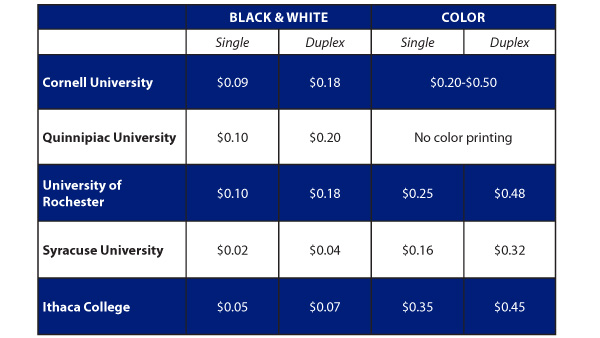Ithaca College is considering a proposal to limit the number of pages that students can print for free per semester to 150–200 pages before having to pay for each printed page.
A project team that includes Information Technology Services and the college’s library is currently negotiating the details of the Print Management Initiative with faculty, staff and the Student Government Association. The proposal will be given to the president’s council for approval, and Beth Rugg, assistant director of technology and instructional support services and project lead for the initiative, said ITS and the library hope to implement the initiative by Fall 2013.
Rugg said the proposed cost of printing black-and-white pages will be five cents for single-sided sheets and seven cents for double-sided, or duplexed, sheets. Printing in color will cost 30 to 40 cents for single-sided sheets and 40 to 50 cents for duplexed sheets.
Marian Brown, special assistant of campus and community sustainability, said one of the main reasons behind the print management program is to reduce the college’s environmental impact.
“The less paper you’re producing, the less land you’re impacting,” Brown said. “When you have forested areas specifically for paper pulp, that is a monoculture. You only have one type of tree, and so you have very limited biodiversity, and it tends to have an impact on soil quality.”
Brown said the program’s efforts to improve sustainability will also improve resource efficiency.
“Paper processing is a very energy-intensive process,” Brown said. “Every ream of paper has a big footprint.”
The college purchased more than 60 tons of paper in the 2008-09 academic year, about 55 tons in 2009-10 and about 51 tons in 2011-12.
College Librarian Lisabeth Chabot said about 143,000 sheets of paper were printed but never retrieved at the library in the last two academic semesters. She said 30 percent of those papers were single-sided and 70 percent of them were duplexed.
Brown could not provide an estimate of how much the unretrieved print-outs cost the college.
Rugg said print management programs are nothing new to higher education institutions, and the Print Management Initiative was waiting on the drawing board at the college for 10 years until Chabot recently revived the discussion.
Cornell University charges nine cents for black-and-white pages, single-sided or duplexed, and 20 to 50 cents for color pages, depending on which lab the student uses. Syracuse University charges two cents for black-and-white pages and 16 cents for color pages. The University of Rochester charges 10 cents for single-sided black-and-white pages, 18 cents for duplexed black-and-white pages, 25 cents for single-sided color pages and 48 cents for duplexed color pages.
Rugg said the initiative proposed that the college will use GoPrint.com, which was established in 1987 and serves over 300 institutions, to allow students and staff to track how many prints the student has made. Rugg said students will enter their ID information into a pop-up before they print, which will show their remaining print allowance or the cost of printing if they have exceeded the limit.
Sophomore Jaclyn Cheri said she believes the initiative is a step in the right direction for improving the college’s environmental conscientiousness by making students think twice before using paper.
“Even though it’s really convenient to be able to print as much as you want, it’s a good idea to be conscious about how much paper we’re using,” Cheri said. “When it’s unlimited, you can be carefree about it and not have a responsibility to save paper.”
Senior Alexander Hilton said the initiative has good intentions but will not mitigate the need for students to print.
“On paper, it will cut down [paper usage] for the college, but realistically, it will just make students print out from a different source,” Hilton said. “In the end, I think the same amount of paper will be used … just who’s paying for it and whose budget it’s coming out of [will change].”
Brown said there has been a gradual transition at the college to use more electronic and online services instead of print material to alleviate the amount of paper used and to improve efficiency. She said Parnassus made time entry for student and college employee jobs much faster, and HomerConnect allowed the college to not have to print 4,000 copies of the 400-page course catalog each year.
However, Brown said, the transition to electronic material may take time, because not all professors are comfortable using Sakai and other Internet services.
“Our students are what are considered digital natives; you grew up with online communication tools,” Brown said. “But for those in my generation, we’re considered to be digital immigrants; we came to this late.”








